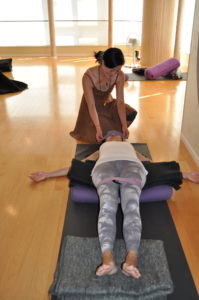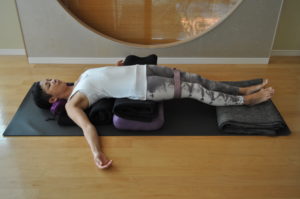
Model: Mayumi Fujita and Teacher: Kitty Hiromi Thompson
by Leza
Supported Bridge pose (Salambha Setu Bandasana) is a gentle backbend that opens your heart, chest, shoulders, neck and throat while restoring the natural curves of your spine, which relieve back pain and/or tension, and allowing your back muscles to rest and relax.
It’s also a very calming pose because the position of the head position and neck—head below the heart and neck flexed—suppresses the sympathetic (fight-or-flight) nervous system response and moves us into the parasympathetic (rest-and-digest) nervous system response, where we restore and replenish our energy. So it’s an excellent choice for reducing stress. When I feel sluggish, tired, or overwhelmed, I find Supported Backbend energizes me and helps to relieve stress, physical tension and fatigue.
Note that although Supported Bridge pose is often done with the feet at the same level as the pelvis, in the version of Supported Bridge pose that I’m showing the feet are lower than the pelvis. This creates a gentle all-over backbend.
To avoid injury, it is a good idea to practice gentle spinal releases first (like Cat-Cow and Supported Child’s pose) before practicing Supported Bridge. Once your back and spine feel looser, you can safely hold Supported Bridge pose in a way that benefits your body without injury.
Caution: Those with severe back and neck issues should avoid this pose. Trauma-sensitive practitioners should avoid this pose if it is triggering.
Setting Up
To set up for the pose, you’ll need the following: yoga mat, 1 bolster, 3-4 blankets, 1 strap, 1 neck pillow, 1 eye pillow.
Start by spreading a yoga mat on the floor. Place the yoga bolster horizontally across the middle of the mat. Place a folded blanket on top of the bolster. Tightly roll a blanket 3/4 of the way, and place it on the mat above the bolster, extending the last 1/4 flat along the head of the mat. The round portion will support your chest, and the flat portion will pad the mat under your head and shoulders. Place a neck pillow or rolled-up towel at the head of the mat. Fold a yoga blanket at the foot of the mat.
To Come into the Pose

Sit on top of the bolster, then slide towards the head of the mat until your upper back is resting on top of the rolled-up portion of the blanket and your shoulders are touching the tip of it, settling on the ground. Your ribcage should feel as if it is “spilling out” to the edges of the blanket as the chest opens wide and the shoulders release. Place a neck pillow or rolled-up towel under your neck so that the natural curve of the cervical spine is supported. Put a cinched belt over your thighs, just above the knees, so your thighs are at hip-width distance. Extend your legs out and allow your calves and ankles to rest on the folded-up blanket at the foot of the mat. Rest your arms at your sides in a comfortable position. Allow the thumbs, palms of the hands, and fingers to soften. Make sure you are evenly laid out, supported, and comfortable. If desired, cover your body with a blanket and/or cover your eyes with an eye pillow.
Variations
For deeper sense of grounding, place a light sandbag on your pelvis, if it is comfortable. Remove it if the backbend becomes too intense.
If the bolster/blanket combination is too high and the backbend too deep, simply use one bolster or, conversely, one blanket, under your lower back.
If the strap is uncomfortable, remove it.
If you do not have a bolster, place one, two, or three folded and stacked blankets horizontally in the center of your mat instead.
If your knees require additional support, slide a rolled-up blanket under them.
If you do not have a blanket to support the calves/feet, use two blocks on their lowest height, with one under each foot. Your heel can hook into the edge of the blanket or blocks.
For a greater sense of containment, the blocks for your feet can also be pushed up against a wall so that the bottoms of your feet can rest against the wall.
Practicing the Pose
Elongate the back of your neck, allowing your chin to release toward your chest. Allow your buttocks to sink down into the bolster and relax. Release your thighs, legs, and feet onto the blanket. Soften your spine and gently release it. Then sense all the places you feel your body making contact with the props and the ground.
Take several slow, deep breaths to release your weight, melting into the supports. Turn your attention inward and focus on your breath. Inhale to lengthen the heart forward as you also release into the support, exhale to soften and expand. Greet the sensations in your back and entire body with an open mind, observing without judgement. If emotions arise, observe them and the changing sensations in loving awareness. If you feel any pain or discomfort, gently come out of the pose.
You can also try releasing tension, stress, anxiety, worry, and exhaustion on the exhalation and cultivating peace, self-love, and comfort on the inhalation.
In quieter holds, anchor your awareness in the sensations in your body by following the breath as it moves in and out, finding stillness as you open and expand into the pose.
Stay from 5-10 minutes as long as there is no discomfort.
When you are finished, bend your knees and place your feet on the outside of the props. Loosen the strap and slide it down your legs so you can move your hips and legs. Lift your hips up to roll off the bolster, coming onto your right side. From there, come onto your hands and knees.
Place the props to the side and come into Child’s pose. Rest there for several minutes. If you like, spend a few minutes in Savasana. Eventually, roll onto your side and enjoy some quiet breaths before coming up slowly, head last.
You can read more about Leza’s writing at www.lezalowitz.com and about her yoga studio and classes at www.sunandmoon.jp.
• Follow Yoga for Healthy Aging on Facebook and follow Nina on Instagram • Pre-order Yoga for Times of Change: Practices and Meditations for Moving Through Stress, Anxiety, Grief & Life’s Transitions here • Order Yoga for Healthy Aging: A Guide to Lifelong Well-Being here


Leave A Comment